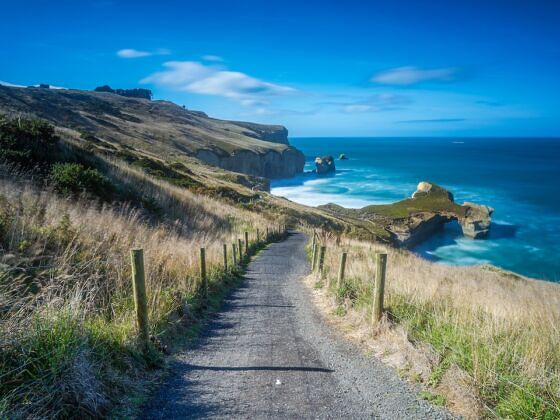FLYING INTO DUNEDIN, the second largest city on New Zealand’s South Island, I was still shaking from my morning bungee jump off the Harbour Bridge in Auckland with some of my new Hawaiian Airlines friends. The assault on my nerves continued when I rented a car and drove for the first time on the left side of the road. My biggest adjustment was finding the turn signal, which was on the opposite side of the steering wheel. Every time I wanted to change lanes, I kept turning on my windshield wipers.

A Literary Pilgrimage: In Search of Janet Frame's New Zealand, Part 3
In 1943, Janet Frame had arrived here from her home in the small town of Oamaru to enroll at Dunedin Training College. Though her ostensible purpose was to become a teacher, her real passion was reserved for the courses in literature she took on the side at prestigious Otago University, the oldest university in New Zealand.
It was also in Dunedin where Frame was committed to a mental asylum for the first time. This occurred during a period of intense grief over the death of her sister by drowning and her loathing of what seemed like her destined profession of teaching. Years later, as a successful writer, she returned to the city, and in 2004 she passed away here at the age of 79.
Like Auckland, the outskirts of Dunedin has its share of drab concrete architecture, but in the center there’s a good deal more charm, thanks to the city’s Scottish-influenced brown brick buildings crowned by Gothic spires.
There was a Fringe Theatre Festival on that weekend, and students in extravagant pink, gold, and fur-lined costumes strutted past the open-air bars and cafes on Princes Street and the town’s central plaza, the Octagon. Their brashness reminded me of my own time in college in Ann Arbor, where I anxiously submitted my confessional stories in creative writing classes and dreamed of seeing my name on the spine of a novel.
After checking into my hotel, I walked across the campus and then away from the center, searching in vain for the house where Janet had stayed as a student, the home of her Aunt Isy in an alley called Garden Terrace, which no longer exists.
To young Janet, this lovely-sounding address promised a light-filled cottage with a view of a terraced garden, but the house was actually a dingy, narrow building in the bad part of town, supposedly frequented by prostitutes and Chinese opium addicts.
I was unable to guess where the house had been, so I climbed up a steep hill to South Cemetery, dense with trees and cracked headstones tilted at odd angles. Here in this hillside cemetery, which had fallen out of use even in her time, Frame escaped from her lodgings to write poetry. She also used the cracked headstones as a hiding place for her dirty sanitary napkins, as she was too embarrassed to give them to her aunt to burn.
I could imagine Frame in her element here, looking out over the town, toward the sea, like a queen ruling her kingdom rather than a shy girl from the countryside, lost in the confusion of campus life.
Along the way back into town, I passed the Grand Hotel, where Frame had once worked as a waitress while writing stories and poems in her spare time. The once elegant restaurant had since been turned into a rather sad casino.
I finished my journey at the ornate train station, whose grandiose style earned its architect the nickname “Gingerbread George.” That evening, a fashion show was taking place there, and as I approached the entrance, a young man in a dark suit held up a clipboard to check my name against his guest list. I had not been invited. I was no one.
“I don’t care about your fashion show,” I snapped. “I’m looking for a plaque dedicated to Janet Frame.” He looked confused. “The New Zealand author,” I explained.
“Wait here,” he said. “I’ll get someone who knows.”
He brought back an older man who worked at the station. “Ah, yes. Janet Frame,” he said. “Angel at My Table. Amazing film. Wasn’t that with Kate Winslet? When she was just starting out?”
“No, you’re thinking of Heavenly Creatures,” I said.
“I’m sure it was Kate Winslet,” he said.
He was wrong about the film, but he pointed me right to the plaque, a brick-sized metal plate in the ground. The fashionistas swept by it on their way to a champagne reception inside the station, where Frame, a railway man’s daughter, once used to buy “privilege tickets” to ride back and forth on weekend visits home.
I took my picture, then headed back to my hotel. It was Saturday night in Dunedin, prime time for partying, but I spent the evening alone in my room, watching clips of Frame as a middle-aged and then elderly woman, speaking with quiet authority and the occasional nervous laugh to interviewers, whom she mostly avoided, fiercely protective of her privacy.
She didn’t care about the values of our world because she had her own, a world of imagination she called a “Mirror City,” a reflection of our world, and by its reflection, an indictment of it too.
Janet Frame didn’t care about plaques or parties to which she had or had not been invited. So why did I?